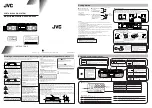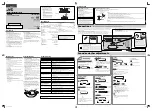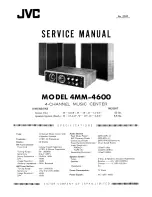
W W W . G O L D E N A G E P R O J E C T . C O M
II
CIRCUIT DESCRIPTION
The main signal path in the EQ-81 MKII
consists of four gain stages, one for
each frequency band. Each gain stage
uses five transitors and a few resistors
and capacitors. The complete eq signal
chain contains only a small number
of active elements. Compare that to
the big number of transistors that are
usually used in one single integrated
circuit! The filter circuits uses additional passive components. The
mid bands uses inductors and capacitors for a classic LC-style eq
circuit.
The EQ-81 MKI was designed to be used in combination with a unit
with a low level insert jack, saving the cost for the classic trans-
former based in- and output stage. The MKII retains the insert
jack connection but an IC-based IO with balanced connections
and the st 4dBu operating level has been added as an
option. This makes it possible for the EQ-81 MKII to operate as a
stadalone unit.
MODERN VERSUS OLD
It is true that there are some great IC´s available today that
achieves very low levels of static and dynamic distortion.The
simple EQ-circuit that the EQ-81 MKII uses, cannot match the low
distortion specifications of modern IC´s.
It is the distortion components that imparts a sound character
to the audio signal and, if the distortion components are of the
right sort, this is a good thing since it makes the recorded voice
or instrument sound “better”, more musical, more pleasing to
the ear. This is one reason why vintage style units are so popular
today.
This is not to suggest that modern, transparent sounding audio
circuits is a bad thing, sometimes they are prefered over colored
ones. It´s all about taste and it depends on the genre. For most
modern music styles, color and character is definitely a good
thing. And doesn´t it feel good to use audio components built
according to the old, minimalistic approach where one can follow
the signal from one discrete component to another?
USING THE EQ-81 MKII
Using an equalizer is not rocket science. Here are some points
though to help you getting the maximum out of the EQ-81 MKII:
- Connect the cable from the power supply to the AC 24V connec-
tor at the back of the EQ-81 MKII. Power on the unit with the front
panel POWER switch.
- Select the operating mode with the LINE IN/INSERT switch on
the back panel, pressing the switch engages LINE IN mode. Con-
nect the signal source to the LINE IN Combo jack and one of the
OUT jacks to the next unit in the signal chain.
- INSERT mode is activated with the switch in its outer position.
Connect the supplied stereo TRS cable between the back panel
TRS jack and the insert jack of one of our PRE-73 models or any
other suitable unit that the EQ-81 MKII will to be used together
with. “Tip” of the TRS is the input and “Ring” is the output.
The two OUT jacks will output the signal also in this mode and
can then be used as an alternative output with a different sound
character.
The EQ-81 MKII in INSERT mode will now be inserted in the signal
path of the PRE-73. If you are using the EQ-81 MKII together with
a PRE-73 DLX, you must engage the INSERT switch to activate the
EQ-81 MKII.
- The best way to learn how to set the controls of the EQ-81 MKII is
to experiment with different settings on different sound sources.
The four bands and the different frequency selections will give you
many possibilities for shaping the sound.
- The BASS and TREBLE bands are of the bell type but can be
switched to a shelving type, ie, it will affect all frequencies below
(Bass) and above (Treble) the selected frequency. The eq action
gradually starts above (Bass) or below (Treble) the selected fre-
quency and increases up to the maximum boost or cut.
The MID bands has bell curves, ie, a cut or boost centered around
the resonance frequency. They can be switched to Hi Q mode
meaning that the eq action will be more narrow around the center
frequency and the maximum boost/cut will be higher.
- By setting the frequency switches to OFF, the eq action of each
band is removed for comparions between eq and no eq.
Using the INSERT switch in the PRE-73 DLX, one can instantly
bypass the complete EQ-81 from the signal path.
- There is a Ground Lift jumper inside the unit, close to the input
combo jack. The jumper should normally be in place.
If the EQ-81 MKIII is mounted in a UNITE rack kit together with
a PRE-73 and / or mounted in a rack where other units are also
mounted, ground loops can give rise to problems. Then try remov-
ing the jumper which will lift the circuit board ground from the
cabinet of the EQ-81 MKII.
PLEASE NOTE:
- The maximum boost and cut varies somewhat with the selected
frequency.
- Inserting the EQ-81 MKII in a PRE-73 will result in a small gain
change.
- Clicks can arise when the controls are operated, This is normal
and a consequence of the used circuit design.
- The inductors and the filter circuits in the EQ-81 MKII are sensi-
tive to electromagnetic fields. If you have a problem with hum
or noise, try moving the unit to another physical location in your
studio.
One situation where this problem is most likely to show up is if
the EQ-81 MKII is mounted above or close to a unit that contain a
power supply with a mains transformer.
WARRANTY
The EQ-81 MKII is built to last. But as in any electronic device,
components can break down.
There is a slow blow fuse located inside the unit. If the unit dies,
please check this fues. If it has blown, replace it with a new one
with a rating of 1A, You can also try with another 24V AC adaptor if
you have one available.
If this doesn´t help, or if the unit has another problem, it will need
repair and you should then contact the reseller where you bought
the unit.
The warranty period is decided by the Distributor for your country.
The Distributor will support Golden Age Project resellers and end
users with repairs and spare parts.
You are welcome to register your unit, go to our website:
www.goldenageproject.com and send us your contact info.
---------------------------
I would like to thank you for chosing the EQ-81 MKII!
I hope it will serve you well and that it will help you in
making many great sounding recordings.
Yours,
Bo Medin
Vintage character
for modern ideas




















